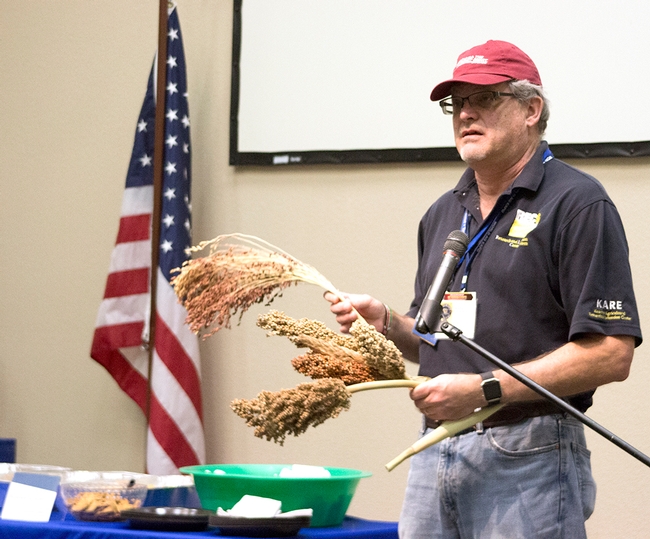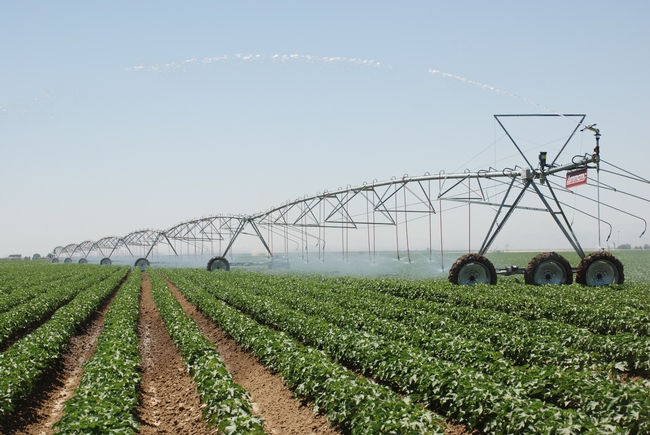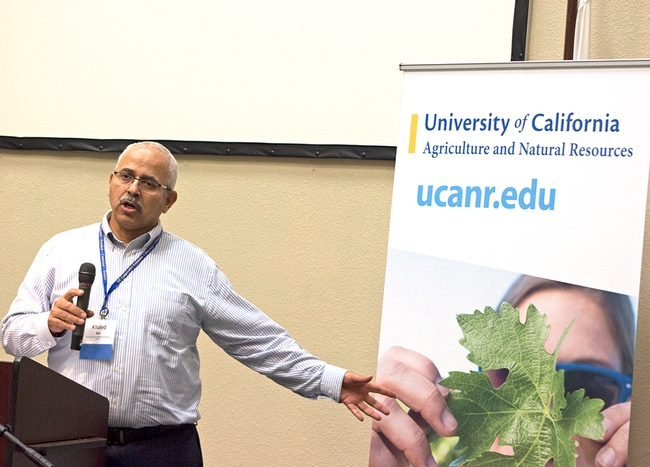
Posts Tagged: Kevin Day
The drought may be over, but water concerns haven't been doused
Record winter rainfall during the 2016-17 winter has enabled farms to emerge from survival mode in the short term, but scientists are still working hard to be ready for the next drought, reported Tim Hearden in Capital Press.
Hearden spent a day at the UC Kearney Agricultural Research and Extension Center in Parlier to learn how researchers at the facility and the UC West Side Research and Extension Center near Five Points are combining technology with management practices to put every drop of irrigation water to work.
“This is one of the few places in the world where you can do drought research on a field level,” said Jeff Dahlberg, director of the 330-acre Kearney facility. “What I'm planning is a world-class drought nursery.”
At the West Side REC, researchers are working with farmers to perfect micro-irrigation efficiency and test drought stress on the area's most prevalent crops.
“We'll grow a tremendous number of cultivars of a crop” and identify “what seem to be the most promising cultivars when you grow them under drought conditions,” said Bob Hutmacher, a cotton specialist and the center's director.
Hearden spoke to Jeff Mitchell, UCCE cropping systems specialist and director of the Conservation Agriculture Systems Innovation center (CASI). CASI is encouraging farmers to adopt farming practices that save water, reduce dust and help improve the condition of soil, such as subsurface drip irrigation, overhead irrigation, minimum tillage, cover crops and crop residues.
“This is not done right now in California,” Mitchell said. “In the future, there may be a strong likelihood of certain agricultural sectors adopting these practices.”
Other subsurface irrigation trials are showing dramatic increases in yields. Khaled Bali, an irrigation water management specialist at Kearney, said underground drip systems in alfalfa fields have achieved 20 to 30 percent more yields while in some cases using 20 percent less water.
Kevin Day, a UCCE pomology advisor in Tulare County, is trying subsurface drip in a peach and nectarine orchard after working with the USDA to use it for pomegranates. He's seen as much as a 90 percent reduction in weeds because there's no surface water to feed them.
“Fewer weeds, fewer pesticides,” he said. “We use high-frequency irrigation. We irrigate as the crop needs it. When you do that, you keep the roots deeper, which makes for better aeration.”
California summer fruit smaller and tastier this year
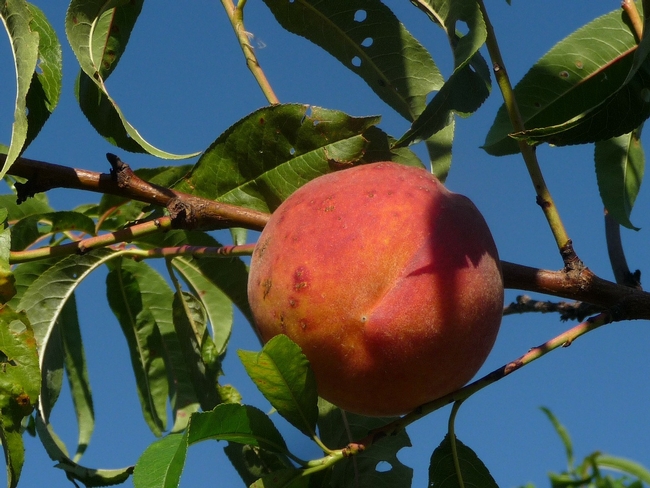
"That smaller peach this year very likely is sweeter than the moderate-sized peach of last year," said Kevin Day, UC ANR Cooperative Extension advisor and director in Tulare and Kings counties.
Most of the change in fruit size can be attributed to the drought. When irrigation is limited, water content of the fruit diminishes and sugars become a greater proportion of the fruit mass. However, Day says drought isn't the only reason for 2015's smaller fruit size. California also had unusually warm temperatures in January and February 2015, causing fruit to ripen faster.
"A variety that might ripen after 120 days of being on a tree in a year like this ripens in only 110," Day said. "And, so it's consequently shortchanged out of 10 days of growing."
UC research on dwarf fruit trees featured on local news

The idea is keeping the fruit trees short so ladders won't be necessary for harvest and other orchard operations, while at the same time maintaining excellent yield and fruit quality.
Day talked to the KSEE news crew in a peach and nectarine orchard at the UC Kearney Agricultural Research and Extension Center in Parlier.
"This is good news for farmers and farmworkers," said reporter Theresa Sardina. "This means safer working conditions for workers and less money out of farmers' pockets."
Day said the researchers are trying to better understand the labor savings aspect of small fruit trees, but he believes they will be proven to be significantly more cost effective.
"You can save a minimum of 25 if not up to 50 percent on any particular labor operations," Day said.
The lead agricultural technician at Kearney, Rudolfo Cisneros, was also interviewed for the story.
See the video on the KSEE Channel 24 website.
VP posts PACE committee report, highlights actions underway
Dear Colleagues:
I am pleased to release ANR Academic Assembly Council (AAC)’s Partnership to Advance Cooperative Extension (PACE) committee report. I also want to share some of the current results of that effort. Part of AAC’s mission is to provide a forum to address the professional needs of Cooperative Extension (CE) academic employees. As such, I charged AAC to seek broad and diverse input from ANR academics related to the roles and responsibilities of CE Specialists and Advisors to support the Division’s mission and vision. Frank Mitloehner, then AAC President, and Kevin Day, Chair of the AAC Policy Committee, co-chaired the diverse ad hoc committee, which included four Advisors, four Specialists (one from each college/school) and one Academic Coordinator.
I want to thank the PACE committee for its thorough effort taking a multi-faceted approach that resulted in a high level of participation statewide. Throughout the process, we heard that their open and transparent process was widely appreciated. I also want to thank all of you who participated in the PACE survey and dialogue sessions for providing your thoughtful and constructive input to inform our work moving forward.
I encourage you to read the report to gain a more in-depth understanding of what was heard across the Division. The full report is posted on the PACE website http://ucanr.edu/sites/pace2013/PACE_Report. Below I will highlight some PACE findings that have already been put into action:
- The preference for more smaller grants was expressed. It was explained that smaller grants are: 1) especially important for CE academics working in areas for which extramural funding is limited; and 2) were identified as a means to increase real collaboration among CE academics. Immediately following the PACE report presentation to Division leadership, we responded by making changes to the 2013 UC ANR competitive grants program RFP to encourage more small grants and provide the opportunity for Extension only proposals.
- ANR academics across campuses and counties widely agreed that the Division is better understood as a network rather than the traditional continuum model. We will continue the transition to describe the Division as a statewide network. We will also further explore what this means in regards to future positions and how we work together.
- Many ANR academics suggested that we develop a mentoring process with a formal orientation program. This need is recognized as a priority by leadership. I will work with the AAC, the Academic Personnel Unit and others to develop mentoring and orientation strategies and materials.
- A notable suggestion was that CE re-establish a “code of conduct” that “emphasizes collegiality, professionalism and communication.” I will work with the AAC to develop a tool to help clarify appropriate protocol when working together and across the statewide network.
- There was significant agreement about the need for “improving training and collaborative opportunities between campus and off-campus academics while at the same time highlighting career opportunities in Extension — especially for current UC students.” Suggestions for methods to do so included the advisor intern program and the emerging Graduate Student in Extension (GSE) program initiated at UC Berkeley. I am talking with students and the Division’s four Deans to explore this pilot.
- The need to improve ANR academics’ ability to find out “who’s who” and “who’s doing what” is recognized. Communications Services and Information Technology with input from others has developed the Taxonomy and Personnel System, which will be finalized and formally launched. We invite feedback on the pilot to make this mechanism best meet your needs: https://ucanr.edu/portal/taxonomy.
- Concern was voiced for the success of the new advisor positions given broader geographic and programmatic assignments. We are closely watching the progress of the new advisor hires. We are pursuing ways to provide support, such as mentoring. We will remain flexible in our approach to serve programmatic needs across the state.
Also in response to the PACE effort, we will provide more information to further enhance our commitment to transparency. In addition, requested documents are posted on the PACE website as they are made available (http://ucanr.edu/sites/pace2013/Additional_Relevant_Information). I will address a few voiced concerns below:
- A concern was voiced about the level of funding to support Specialists’ work. We have been working with the Deans’ Offices to pull together information to elucidate the funding provided for Specialists. When this is finalized we will share it.
- It was reported that smaller, more focused efforts, e.g. those provided by Workgroups, are essential to support the broader ANR mission and vision. I want to reiterate that the Division continues to support Workgroups. The only thing that has changed over the past few years is how Workgroups get together.
- It was requested that ANR clarify the CE position allocation process. Given our commitment to making this a fair and transparent process, we are happy to provide again the description of the process with the criteria, as well as to try to improve our communication of the rationale behind the decisions.
The results of the PACE effort will continue to be discussed by Division leadership and across the network to inform future positions and how we work together. I respect the important role AAC plays within the Division. I appreciate the PACE committee’s dedicated leadership and the ANR community’s enthusiastic participation. I look forward to continuing to work together to strengthen our network, within and external to UC.
Barbara Allen-Diaz
Vice President
View or leave comments for ANR Leadership.
This announcement is also posted and archived on the ANR Update pages.
Heat wave takes a toll on San Joaquin Valley agriculture
Six consecutive days of San Joaquin Valley temperatures topping out over the 100-degree mark are impacting agricultural production, reported Bob Rodriguez in the Fresno Bee.
Rodriguez talked to UC Cooperative Extension farm advisors to learn about the recent hot weather's effect on tree crops and grape vines.
"Trees and plants just seem to shut down when it gets this hot," said Kevin Day, University of California Cooperative Extension advisor in Tulare County. "And the fruit just doesn't ripen."
Grape growers face similar challenges when the mercury rises.
"Instead of producing sugar and enlarging the berries, the vines just maintain," said Stephen Vasquez, UCCE advisor in Fresno County, viticulture.
The high temperature around the Valley is expected to be about 101 today. More pleasant weather begins Saturday, when temperatures return to normal for this time of year, the mid- to upper 90s.
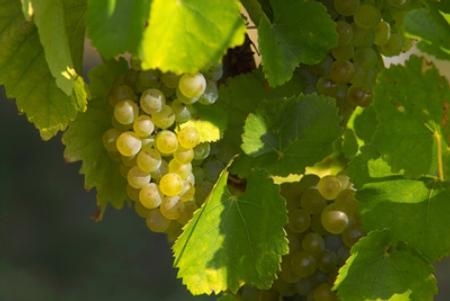
When the weather gets really hot, grapes go into survival mode.
